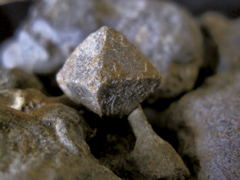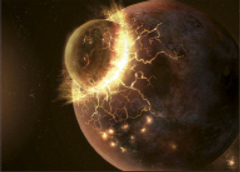
Campus Moncloa
Campus of International Excellence
Hadean
~4600-4000 M.a.
Term derived from Hades, god of the underworld in Greek mythology.

A zircon is forever: The only material that still exists from the time of the Earth’s origin in the Hadean is zircon, a very resistant material.

The impact of an asteroid on Earth gave birth to the moon.
Some 10,000 Ma after the Big Bang the remotest period of our planet’s history begins: The Hadean. Even its name - in memory of the Greek god Hades, lord of the underworld - denotes the desolation of a hot, barren Earth without liquid water where meteorite impacts are continuous and violent.
The Earth does not preserve any rocks from this period although they exist in other bodies in the solar system. However, we can still see the results of these turbulent times: the Moon and the internal structure of the planet.
The impact of an asteroid rips the Moon from the Earth. The internal structure of our planet is due to the sinking of the heavier elements (iron, nickel) to the centre of the Earth where they form a metallic core, while the light elements (silicon, oxygen, carbon) accumulate on the outermost layers.
| Hadean | ~4600-4000 M.a. |
| Archean | 4000-2500 M.a. |
| Proterozoic | 2500-541 M.a. |
| Cambrian | 541-485 M.a. |
| Ordovician | 485-443 M.a. |
| Silurian | 443-419 M.a. |
| Devonian | 419-359 M.a. |
| Carboniferous | 359-299 M.a. |
| Permian | 299-252 M.a. |
| Triassic | 252-201 M.a. |
| Jurassic | 201-145 M.a. |
| Cretaceous | 145-66 M.a. |
| Paleogene | 66-23 M.a. |
| Neogene | 23-2,6 M.a. |
| Quaternary | 2,6 M.a.-act. |
